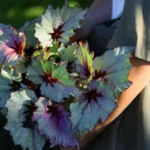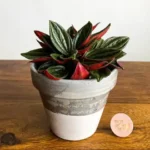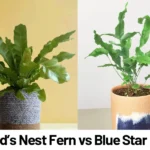Meet Calathea roseopicta: A Showstopper in the Indoor Jungle
If you’re a fan of foliage and want to bring a splash of color and character to your indoor plant collection, Calathea roseopicta is a must-have. Known for its lush, velvety leaves and stunning visual appeal, this tropical plant hails from the rainforest undergrowths of South America. With its deep green background and pinkish to silvery markings, it rightfully earns its place among the most ornamental houseplants for plant lovers and beginner gardeners alike.
Understanding Calathea roseopicta
Calathea roseopicta belongs to the Marantaceae family, commonly referred to as the “prayer plant” family. This name comes from their unique nyctinastic movements, where the leaves fold upward at night and reopen in the morning, as if in prayer. The species showcases a range of cultivars such as ‘Dottie,’ ‘Medallion,’ and ‘Rosy,’ each with slightly different coloration and patterns, adding to their appeal and collectability.
Native Habitat and Growth Habit
In its native habitat—humid tropical forests—Calathea roseopicta thrives in dappled light under the forest canopy. These environmental needs affect how you should care for the plant indoors: it loves warmth, high humidity, and gentle lighting to flourish and remain vibrant.
Essential Care Tips for Calathea roseopicta
Calatheas are often perceived as finicky, but with the right conditions, they can thrive indoors for many years. Here’s your in-depth guide on how to meet their care needs with confidence.
Light Requirements
Calathea roseopicta loves bright, indirect light—think morning sunlight filtered through sheer curtains. Avoid placing it in direct sunlight, as this can bleach or scorch its beautiful foliage.
- Ideal: Near an east or north-facing window.
- Too much light: Leaves may become faded or washed out.
- Too little light: Slower growth and less vibrant colors.
Watering Needs
This plant enjoys consistently moist—but not soggy—soil. Letting the plant dry out too much between waterings can cause leaf edges to brown. On the other hand, overwatering can lead to root rot.
- Stick to a regular watering schedule—about once a week.
- Always check the top inch of soil; if it feels dry, it’s time to water.
- Use filtered or distilled water if possible. Tap water containing chlorine, fluoride, or high minerals can damage the plant.
Humidity and Temperature
As a tropical plant, Calathea roseopicta absolutely thrives in high humidity and warm temperatures.
- Optimal humidity: 50% or higher. Consider running a humidifier near the plant.
- Quick tips: Group it with other plants, place it on a pebble tray with water, or mist it regularly to boost humidity.
- Temperature range: 65–80°F (18–27°C). Avoid cold drafts and sudden temperature changes.
Soil and Potting
Calatheas prefer light, well-aerated, and slightly acidic potting soil. A good potting mix will retain moisture without becoming waterlogged.
- Look for mixes designed for African violets or make your own with peat, perlite, and pine bark.
- Make sure the container has drainage holes to prevent water sitting at the bottom.
Fertilizing
Calathea roseopicta doesn’t need much feeding but will appreciate a boost during its growing season (spring and summer).
- Use a balanced, water-soluble fertilizer diluted to half-strength every 4-6 weeks.
- Stop feeding in fall and winter when growth naturally slows down.
Pruning and Maintenance
These plants don’t require heavy pruning. Simply snip away any yellow or damaged leaves close to the soil line to encourage new growth and maintain a tidy appearance.
- Disinfect pruning shears before use to avoid spreading disease.
- Wipe leaves occasionally with a damp cloth to remove dust and keep them breathing freely.
Common Issues and How to Troubleshoot
Brown Leaf Tips or Edges
Often a result of low humidity or fluoride in tap water, brown tips are one of the most common problems. Switch to distilled water and boost humidity to give your plant a better environment.
Curling Leaves
Leaf curling can indicate underwatering, low humidity, or exposure to cold drafts. Adjust your watering schedule and check the placement of the plant.
Yellowing Leaves
This may point to overwatering, poor drainage, or even nutrient deficiency. Ensure your pot has good drainage and your watering habits match your specific indoor conditions.
Pests
Calatheas are vulnerable to common houseplant pests like spider mites, mealybugs, and aphids.
- Check leaf undersides regularly.
- Use insecticidal soap or neem oil for treatment.
- Keep humidity up—it helps deter spider mites, which thrive in dry environments.
Propagation: Sharing Calathea Roseopicta With Others
Unlike some other houseplants, Calathea roseopicta cannot be propagated from leaf cuttings. Instead, division during repotting is the most successful method.
- Plan to divide in spring or early summer when repotting.
- Gently separate new growth from the main plant, ensuring each division has roots attached.
- Replant divisions in moist, well-draining soil and keep humidity high while the plant establishes.
The Reward of Growing Calathea roseopicta
Though some say it’s a tricky plant, Calathea roseopicta more than makes up for its fussiness with elegant, bold leaves and a natural rhythm that breathes life into indoor spaces. With a bit of attention to its lighting, humidity, and watering needs, this plant can be a long-lived and visually stunning part of your indoor garden.
Whether you’re just starting your plant collection or expanding into more exotic foliage, Calathea roseopicta offers an unbeatable combination of artistry and personality. As you adjust to its rhythm and refine your care techniques, you’ll find this living work of art a delightful, ever-changing member of your home.
References
- Hay, A. (2000). Marantaceae. In K. Kubitzki (Ed.), The Families and Genera of Vascular Plants (Vol. 4, pp. 429–442). Springer.
- Masters, C. (2022). Indoor Plant Care Made Easy. Houseplant Central Publishing.
- University of Florida IFAS Extension. (2021). Prayer Plants: Caring for Marantas, Calatheas, and Ctenanthe. Retrieved from https://edis.ifas.ufl.edu








